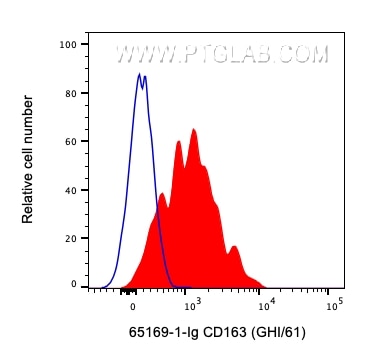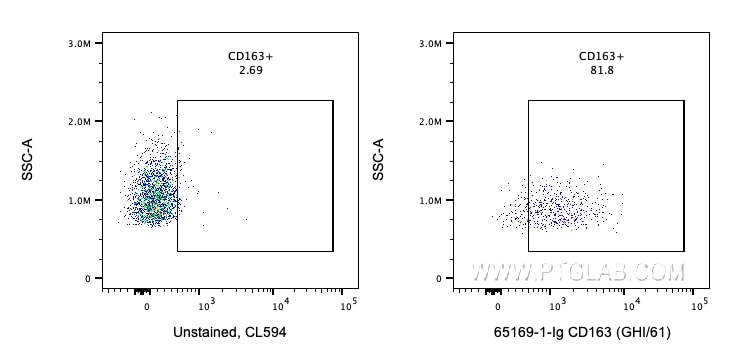CD163 Monoklonaler Antikörper
CD163 Monoklonal Antikörper für FC
Wirt / Isotyp
Maus / IgG1, kappa
Getestete Reaktivität
human
Anwendung
FC
Konjugation
Unkonjugiert
CloneNo.
GHI/61
Kat-Nr. : 65169-1-Ig
Synonyme
Geprüfte Anwendungen
| Erfolgreiche Detektion in FC | humane PBMCs |
Empfohlene Verdünnung
| Anwendung | Verdünnung |
|---|---|
| This reagent has been tested for flow cytometric analysis. It is recommended that this reagent should be titrated in each testing system to obtain optimal results. | |
| Sample-dependent, check data in validation data gallery | |
Produktinformation
65169-1-Ig bindet in FC CD163 und zeigt Reaktivität mit human
| Getestete Reaktivität | human |
| Wirt / Isotyp | Maus / IgG1, kappa |
| Klonalität | Monoklonal |
| Typ | Antikörper |
| Immunogen | Glykoprotein-Zubereitung aus Haarzell-Leukämie-Milz |
| Vollständiger Name | CD163 molecule |
| Berechnetes Molekulargewicht | 1156 aa, 125 kDa |
| GenBank-Zugangsnummer | BC051281 |
| Gene symbol | CD163 |
| Gene ID (NCBI) | 9332 |
| Konjugation | Unkonjugiert |
| Form | Liquid |
| Reinigungsmethode | Protein-G-Reinigung |
| Lagerungspuffer | PBS with 0.09% sodium azide |
| Lagerungsbedingungen | Store at 2-8°C. Stable for one year after shipment. |
Hintergrundinformationen
CD163, also known as M130, is a membrane glycoprotein which belongs to the scavenger receptor superfamily (PMID: 8370408). It is an acute phase-regulated and signal-inducing macrophage protein expressed exclusively in monocytes and tissue macrophages (PMID: 11196644). CD163 mediates endocytosis of haptoglobin-haemoglobin complexes (PMID: 11196644). The uptake of haptoglobin by macrophages contributes to the recycling of iron and also to the inflammatory response (PMID: 22900885). Soluble CD163 (sCD163), as a result of ectodomain shedding during inflammatory activation of macrophages, circulates in blood and has been suggested as a plasma/serum marker for macrophage activity (PMID: 12570164).
Protokolle
| PRODUKTSPEZIFISCHE PROTOKOLLE | |
|---|---|
| FC protocol for CD163 antibody 65169-1-Ig | Download protocol |
| STANDARD-PROTOKOLLE | |
|---|---|
| Klicken Sie hier, um unsere Standardprotokolle anzuzeigen |



